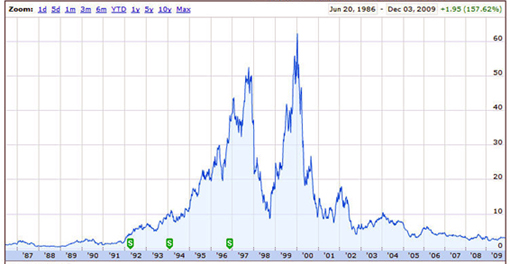This article is more than 1 year old
Adaptec - the eternal wannabe
Serial acquisition FAIL
Dot com boom
The dot.com boom took off in 1998 but Adaptec missed the initial boat. It tried to buy Symbios Electronics for $775m, but the FTC stopped the deal on anti-trust concerns. Sales started falling and Saviers had no plan B. The CFO resigned and Saviers went a short while afterwards. Adaptec was in turmoil and Larry Boucher came back to stabilise the now listing ship. He acted quickly, making 850 layoffs, and selling off a Peripheral Technology Solutions division, which made hard disk drive controllers, to STMicroelectronics. Adaptec exited the satellite networking business, got out of Fibre Channel, the external storage business too, and cut its R&D spending.
The lesson here was that Adaptec's core competency and market strength was SCSI adapters and RAID controllers - focussed components, not Fibre Channel HBAs, and not storage drive arrays. This lesson was only partially learned. For now though, the focus was firmly back on SCSI I/O adapters, where it led the market, and RAID controllers, where it was also dominant. Revenues for the 1998 fiscal year were $965m, Adaptec's record high, although the share price dipped momentarily below $10 in the year.
The dot com boom was in full swing in 1999. A revitalised Adaptec, now led by the previously-mentioned Robert Stephens, was back on the acquisition trail and bought DPT for $235m to strengthen its RAID product line. Its share price recovered and passed $60 as 1999 transitioned to 2000. Adaptec's financial year ends on March 31 and the 1999 revenues were $642.4m with a loss of $13.3m, its first loss since the IPO, and time pretty well perfectly for the ending of the dot com bubble. It burst in March and Adaptec's stock price sank precipitously.

Adaptec stock price history (sourced from Google).
Dot.com bust
In 2001, revenues sank to $578.3m with a profit of $39.6m. Adaptec spun off its CD authoring software operation as Roxio. 2002 saw a revenue decline to $418.8m and a loss of $196.2m. Adaptec's fortunes were heading rapidly south. Stephens came up with an end-to-end block and file networked storage solution strategy. He went on a bit of an acquisition spree in 2003 to get the bits he needed, buying ICP Vortex for RAID hardware and software technology and EuroLogic for its external SAN storage.
Adaptec had DuraLAN Ethernet NIC products, a DuraStor external storage business. It found that SCSI storage was losing share at the low end to SATA and it launched SATA RAID Cards. IDE RAID controller sales were larger than SCSI ones as Adaptec failed to translate its strong non-serial RAID and adapter business position to the serial world. The 2003 revenues were $408m with a loss of $15.4.
The Eurologic acquisition soured as it delivered less than half the hoped-for revenues. Nevertheless Stephens continued buying in 2004. Adaptec bought Elipsan for storage virtualisation software, also some business continuity technology. Apparently there was the idea of morphing its RAID controllers into IP SAN controllers. In July, it bought a RAID technology business from IBM, IBM having bought the Mylex RAID Controller in 1999. There was a contract to supply RAID controllers to IBM for three years as part of the deal.
Adaptec also set up a chip design operation in India with a $25m 3-year investment plan. Lastly, Stephens made what became one of Adaptec's worst-ever acquisitions; he bought Snap Appliance, a successful supplier of low-end NAS arrays, for $100m.
Snap, bang, wallop
It was a steep price but NetApp was also in the running. Adaptec wanted to be a major storage box supplier to small and medium business (SMB) though not to enterprises, so it bought the leading, in a volume sense, NAS supplier to that market. Although it would be competing with its OEM channel it hoped that they would buy the Snap servers and resell them under their own brands, augmenting the other indirect channel sales. It proved to be a fatuous hope and a major mistake. But the immediate thing was that 2004 revenues rose significantly to $452.9m with profits of $62.9m. Things looked good enough at the time, two years of losses had ended and revenue falls had stopped.
In 2005, Adaptec renegotiated the RAID controller supply deal after poor results and received a $22m payout. Things were rapidly turning sour again. Although revenues climbed again, to $475m, there was a thumping great $145.1m loss. Stephens left the CEO job and, after Scott Mercer took the role on an interim basis, Sundi Sundaresh came in to do as Boucher had done seven years before; get rid of the storage box dross, cut costs, and concentrate on RAID controllers, this time SATA and SAS ones.
The trouble was no-one wanted to buy the Snap business, so Sundaresh decided to keep it and invest in it to make it a better product with new models and intentions to add replication, disk-to-disk backup and virtual tape library (VTL) capabilities. The 2006 revenue figure was a poor-ish $344.1m with another horror story of a loss, $148.4m. Sundaresh didn't know it but this was the start of a terminal decline. Adaptec's end game had started.
